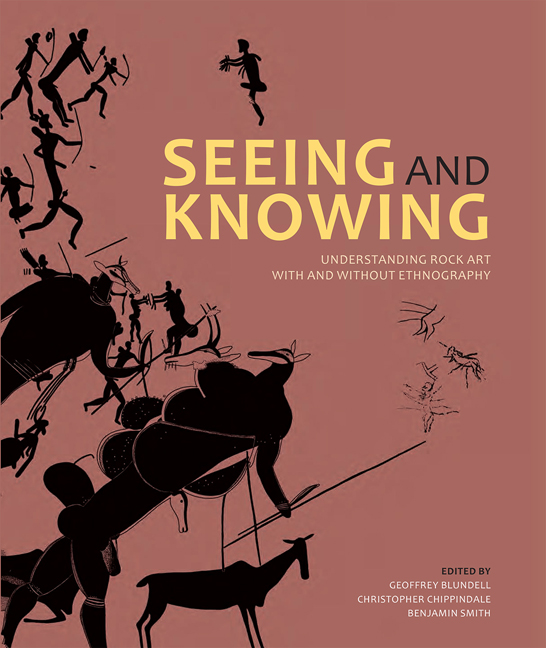Book contents
- Frontmatter
- Dedication
- Contents
- Contributors
- Acronyms
- Chapter 1 Rock art with and without ethnography
- Chapter 2 Flashes of brilliance: San rock paintings of heaven's things
- Chapter 3 Snake and veil: The rock engravings of Driekopseiland, Northern Cape South Africa
- Chapter 4 Cups and saucers: A preliminary investigation of the rock carvings of Tsodilo Hills, northern Botswana
- Chapter 5 Art and authorship in southern African rock art: Examining the Limpopo-Shashe Confluence Area
- Chapter 6 Archaeology, ethnography, and rock art: A modern-day study from Tanzania
- Chapter 7 Art and belief: The ever-changing and the never-changing in the Far west
- Chapter 8 Crow Indian elk love-medicine and rock art in Montana and Wyoming
- Chapter 9 Layer by layer: Precision and accuracy in rock art recording and dating
- Chapter 10 From the tyranny of the figures to the interrelationship between myths, rock art and their surfaces
- Chapter 11 Composite creatures in European Palaeolithic art
- Chapter 12 Thinking strings: On theory, shifts and conceptual issues in the study of Palaeolithic art
- Chapter 13 Rock art without ethnography? A history of attitude to rock art and landscape at Frøysjøen, western norway
- Chapter 14 ‘Meaning cannot rest or stay the same’
- Chapter 15 Manica rock art in contemporary society
- Chapter 16 Oral tradition, ethnography, and the practice of north American archaeology
- Chapter 17 Beyond rock art: Archaeological interpretation and the shamanic frame
- List of figures
- List of tables
- List of publications by david Lewis-williams
- Index
Chapter 17 - Beyond rock art: Archaeological interpretation and the shamanic frame
Published online by Cambridge University Press: 21 April 2018
- Frontmatter
- Dedication
- Contents
- Contributors
- Acronyms
- Chapter 1 Rock art with and without ethnography
- Chapter 2 Flashes of brilliance: San rock paintings of heaven's things
- Chapter 3 Snake and veil: The rock engravings of Driekopseiland, Northern Cape South Africa
- Chapter 4 Cups and saucers: A preliminary investigation of the rock carvings of Tsodilo Hills, northern Botswana
- Chapter 5 Art and authorship in southern African rock art: Examining the Limpopo-Shashe Confluence Area
- Chapter 6 Archaeology, ethnography, and rock art: A modern-day study from Tanzania
- Chapter 7 Art and belief: The ever-changing and the never-changing in the Far west
- Chapter 8 Crow Indian elk love-medicine and rock art in Montana and Wyoming
- Chapter 9 Layer by layer: Precision and accuracy in rock art recording and dating
- Chapter 10 From the tyranny of the figures to the interrelationship between myths, rock art and their surfaces
- Chapter 11 Composite creatures in European Palaeolithic art
- Chapter 12 Thinking strings: On theory, shifts and conceptual issues in the study of Palaeolithic art
- Chapter 13 Rock art without ethnography? A history of attitude to rock art and landscape at Frøysjøen, western norway
- Chapter 14 ‘Meaning cannot rest or stay the same’
- Chapter 15 Manica rock art in contemporary society
- Chapter 16 Oral tradition, ethnography, and the practice of north American archaeology
- Chapter 17 Beyond rock art: Archaeological interpretation and the shamanic frame
- List of figures
- List of tables
- List of publications by david Lewis-williams
- Index
Summary
There are images carved into or painted on rock – a perspectiv e of a village seen from the height of a nearby hill, a single line depicting a woman's back bent over a child – that have altered sarath's perceptions of his world (Ondaatje 2000: 156).
INTRODUCTION: southern african rock art research, in southern africa and elsewhere
Let us take as our subject the archaeological enquiry into the prehistoric mind, considering all its aspects, including ancient cognition, spirituality, symbolic storage and many others. If we review the work that has been undertaken over the last 20 years or so then it is clear that one particular framework of interpretation has become increasingly prominent: the study of shamanism.
Although this has embraced a variety of fields from portable material culture to monumental architecture, it is primarily through research into rock art that a shamanic focus has become well known in archaeology (see for example the numerous references to shamanism in Whitley [2005]). In particular, this is a development that has arisen from the work undertaken by David Lewis-Williams and his colleagues in southern Africa.
In the context of the present volume it would be superfluous to summarise this research in detail, but for the benefit of readers perhaps coming fresh to this subject it is worth considering the sheer extent to which these perspectives have broken through in archaeological interpretation. Building on the platform earlier established by scholars such as Patricia Vinnicombe (e.g. 1975, 1976) and not least David himself in his classic Believing and Seeing (1981), from the early 1980s onwards it is possible to trace a conti - nuously developing tradition in southern African rock art studies, encompassing several parallel strands of enquiry in a unified study of shamanic belief systems. These include the fundamental research into entoptic phenomena, dreams, transformation and spirit animals (e.g. Lewis-Williams 1987, 1988a, 1988b, 1992, 1995, 2001a; Lewis-Williams & Dowson 1989), and the crucial concept of the rock surface as a membrane between the worlds (Lewis-Williams & Dowson 1990), subsequently developed into a unitary thesis of San spirituality (Lewis-Williams 2001b, 2002a; Lewis- Williams & Pearce 2004).
- Type
- Chapter
- Information
- Seeing and KnowingUnderstanding Rock Art With and Without Ethnography, pp. 280 - 289Publisher: Wits University PressPrint publication year: 2010



